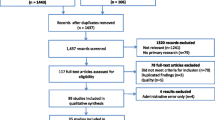Abstract
DSM data are often used to build statistics on the types of patients to whom mental health services are offered. These statistics are normally based on broad categories that cluster finer subcategories for specific diagnoses. These broad categories can be built in a number of ways. The purpose of this study is to determine the effect of the choices made in forming broad DSM categories, by observing the resulting differences in clinical health statistics. Results based on 3496 clinical cases show that DSM-III-(R) classifications can be presented in different formats, leading to different outcomes. To avoid wrong conclusions based on one format, DSM statistics should always be presented in varying formats.
Similar content being viewed by others
Author information
Authors and Affiliations
Additional information
Accepted: 15 February 2000
Rights and permissions
About this article
Cite this article
van Yperen, T., van Engeland, H., Cohen-Kettenis, P. et al. Using DSM diagnoses for clinical, research, and administrative purposes. European Child & Adolescent Psychiatry 9, 255–262 (2000). https://doi.org/10.1007/s007870070028
Issue Date:
DOI: https://doi.org/10.1007/s007870070028




